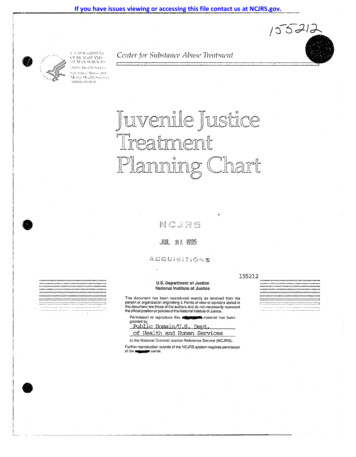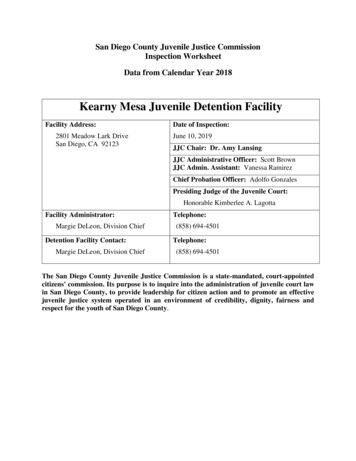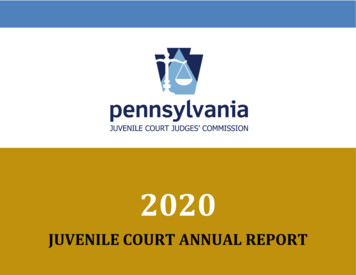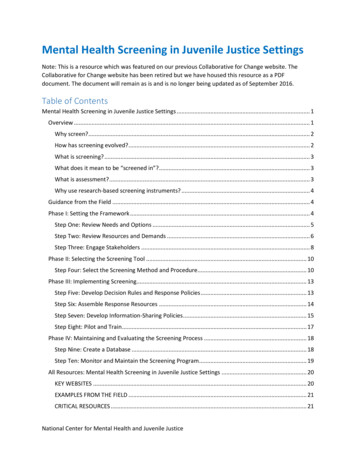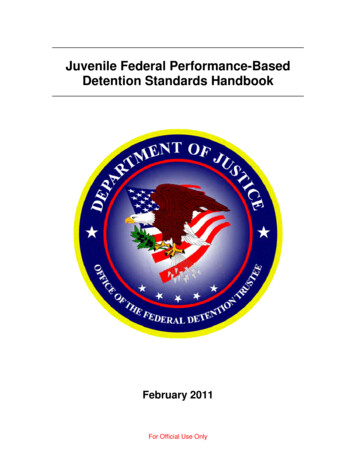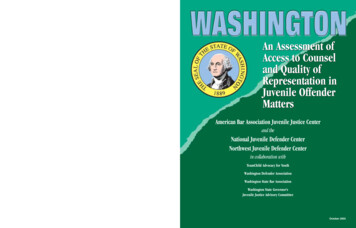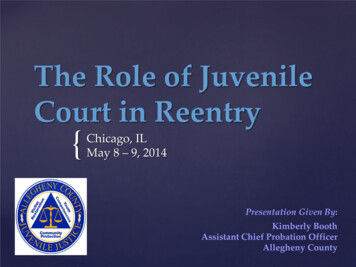
Transcription
The Role of JuvenileCourt in Reentry{Chicago, ILMay 8 – 9, 2014Presentation Given By:Kimberly BoothAssistant Chief Probation OfficerAllegheny County
The Mission of the Allegheny CountyJuvenile Court Probation DepartmentTo Reduce and Prevent Juvenile Crime, Promote and Maintain SafeCommunities, and Improve the Welfare of Youth and Families who areServed by the Court.The Principle Belief Supporting the Mission Are: That the disposition of juvenile offenders always takes into accountthe best interests of public safety.That juvenile offenders be held accountable for the harm they cause toindividuals as well as the community at large.That the primary objective of treatment is to improve and develop thejuvenile offender’s competency skills.That community residents and organizations be actively engaged bythe court in a cooperative effort to seek solutions to juvenile crime.That excellence in the quality of court services requires sensitivity toracial, ethnic, and cultural diversity of the client population.That victims are all integral parts of the justice system and shouldhave their rights protected during all phases of the court proceedingsincluding the right to be heard, notified, and restored.
Allegheny County Demographics There are approximately 1.2 million people in AlleghenyCounty There were a total of 3,788 referrals in 201379% of the referrals were maleMost frequent referrals were assault relatedSecond most common reason for referrals were drug relatedchargesTotal cases closed in 2013 were 1,526Of cases closed, total amount of restitution paid was 190.006Average length of supervision – Probation – is 24 monthsNumber and percentage of offenders who successfullycomplete a three hour Victim Awareness Curriculum is 1,048 –99%108 Probation Officers and 32 Supervisors
Allegheny County DemographicsUS Census 2010Population -1.22 Million 730 Square Miles 130 MunicipalitiesIncluding Pittsburgh 43 School Districts Population Age 10 - 19148,330 Over 140 PoliceDepartments
5th Judicial District of PAPA System – Decentralized 67 Counties: Probation is under Judicial BranchJuvenile Court Judges Commission – advisory body, establishstandardsProbation handles case from opening to closingAllegheny County: Among the 25 largest court systems in the nation43 Common Pleas Court Judges46 Managerial DistrictsMore than 1,200 employees
Probation Department Units(Decentralized in 1974) Intake DepartmentCommunity Based Probation(7 Supervisor Units) D&A Unit Sex Offender Unit YLS Unit Warrant UnitSchool Based Probation (6Supervisor Units) Educational SpecialistCommunity IntensiveSupervision Program (CISP 6Centers)
Educational Specialist – Aftercare InitiativeThe Department has threeEducational Specialists whowork closely with probationofficers, residential providers,home school staff, and theAllegheny Intermediate Unit toimprove educationalreintegration for delinquentyouth existing residentialplacement.
Educational Specialist – Aftercare Initiative(continued)The Education Specialists are continuing to help theDepartment advance important education objectivesincluding the following: Gathering and updating key information regardingeducation programming available through our residentialproviders; Working closely with the Allegheny Intermediate Unit toensure all relevant school information is promptlytransferred to the residential provider upon commitmentand back to the home school upon release; Collaborating with Pittsburgh Public Schools and otherschool districts to establish a consistent protocol forreintegration, curriculum alignment, and credit transfer;
Educational Specialist – Aftercare Initiative(continued)The Education Specialists are continuing to help theDepartment advance important education objectivesincluding the following (continued): Assisting the probation officer in developing a “Case Plan” inconsultation with the provider and home school; the Case Planincludes educational goals, objectives, and activities that beginin placement and continue through the aftercare (post release)phase when the youth returns to the home school; Monitoring and overseeing educational plans for those youthentering and exiting residential facilities;Scheduling and facilitating School Reintegration Meetings toensure a smooth transition from out-of home placement back tothe juvenile’s home school; for the 2011-2012 school year, 91such meetings occurred.
Educational Specialist – Aftercare Initiative(continued)The Education Specialists are continuing to help theDepartment advance important education objectivesincluding the following (continued): Reporting educational outcomes for juveniles returning fromplacement and monitoring the status of juveniles who hadschool reintegration meetings (SRM’s) at the 45-day point andagain at the end of the school year. The educational specialists also assist in updating ourdepartments institutional providers database. The focus on this year is to develop a collaborative processwith the placement and aftercare providers, probation officerand BJJS career tech ed. Specialist to better engage youth whoare returning from placement with a GED or H.S. diploma, injob skill development/training programs to help these olderyouth succeed in their home community. By doing so we arehoping to reduce their risk to recidivate and keep themproductive in the pursuit of their chosen career path.
RECONNECTINGDELINQUENT YOUTHMost school drop-outs are not delinquentBUTMost delinquent youth do not graduate from high schooland cannot find jobsYouth sent to residential placement are most at risk
RECONNECTING LOSTYOUTHLINK BETWEEN DELINQUENCY AND ACADEMICFAILURE WELL DOCUMENTED Majority of youth who are sent to out of home placement do notgraduate high school after reentryWithout basic skills, youth not equipped for 21st century jobsVAST MAJORITY OF ADULT PRISONERS DID NOTCOMPLETE HIGH SCHOOLHigh cost to society in human and monetary capitalWe can break cycle of failure by making high school relevant,directly connected to job preparation and post secondary optionsfor all youth
BACKGROUND TO PACTTIn 2005 PA became first MacArthur Modelsfor Change state, with one of its focuses onrevamping aftercarePA Joint Statement on Aftercare signed bykey partners, included academic andemployment focusPhiladelphia and Allegheny Counties(represent together 2,000 of 5,000 placedyouth) began work on education andemployment goals, identified commonsystemic problems
BACKGROUND TO PACTTMacArthur All Sites meetings madesignificant progress in identifying modelaftercare practices: Need collaborative focus, includingschools, workforce system, social servicesystems, providersPlanning for re-entry begins at time ofplacementPlacement facilities and communityprograms must be seamless, includingacademic workEntire process must be guided byprobation single plan, which moves withyouth from initial intake throughdischarge from the system
RECONNECTING LOST YOUTH :Challenges to Academic SuccessYouth significantly behind gradelevel; low literacy, weak bondingto school Rolling admissions anddischarges CTE programs historically closedto them Weak work habits (soft skills); notfamiliar with work culture; littlework experience Low expectations from systemsthat serve the youth
RECONNECTING LOST YOUTH :Challenges to SuccessSTATE’S DE-CENTRALIZED JJ STRUCTURE BOTH ASTRENGTH AND A CHALLENGEMajority of placement facilities privately run, paidthrough county contracts 67 counties Historically inconsistent expectationsOver 150 private facilities Juvenile justice system has not paid attention toacademics and job training
NO COUNTY, FACILITY or SYSTEM CAN DO IT ALONE:THE PACTT IS BORN, 4/08Allegheny and Philadelphia Probation joined tolead statewide effort to improve academic andemployment outcomes in placement PACTT sponsored by PA Council of Chief JuvenileProbation OfficersFunded by MacArthur Foundation, PCCD andStoneleigh CenterCross-system Advisory BoardFocus on largest facilities serving 2/3 of youth fromAllegheny and Philadelphia Counties
Community Intensive SupervisionProgram (CISP) Court Operated Program Step-up from Probationsupervision Alternative to residentialplacement Aftercare (step-down) forjuveniles released fromplacement since 1997
Community IntensiveSupervision Program (CISP) Nationally Known as an IntensiveSupervision ProgramOperates Out of 6 NeighborhoodCenters around Pittsburgh Garfield, Hill District,McKeesport, North Side, PennHills, and WilkinsburgModel Site for the BalancedApproachStarted in June 1990 Has served approximately 4,300ClientsHas Won Several Awards
CISP – Typical DaySchool Accountability: Monitoring checks with school regarding ATTENDANCE:3:45 – 4:00Youth Reports to Center (class cards collected and reviewed)4:00 – 5:00Homework; Computerized Educational Program;Drug Testing5:00 – 6:00Dinner and Clean Up6:00 – 8:00Drug Testing; Individual & Group Counseling;Community Service8:00 – 9:00Therapeutic Recreation Activity9:00 – 10:00 Transport Youth Home10:30 – 11:30 Staff Check on Youth and Contact Parents
LEVEL SYSTEM OVERVIEWLEVEL 1COMMUNITY SAFETYOBSERVATION/ASSESSMENTDRUG AND ALCOHOLBEHAVIOR FAMILY SCHOOLESTABLISH NORMSMALEBIOLOGICAL SEXREMAIN IN CENTERVICTIM EDUCATIONCOMMUNITY SERVICELEVEL 2COMPETENCYDEVELOPMENTCOUNSELING/REMEDIATIONDRUG AND ALCOHOLBEHAVIOR FAMILY SCHOOLESTABLISH COMPLIANCEBOYHOODDEPENDED undisciplinedbehaviors passion drivenLEVEL 3ACCOUNTABILITYAFTERCARE PLANNINGDRUG AND ALCOHOLBEHAVIOR FAMILY SCHOOLESTABLISH LEADERSHIPMANINDEPENDENT disciplinedbehaviors control of thoughtssenses/actionsPAID ACTIVITIESPARENT PERMISSIONACTIVITIESVICTIM ONRESTITUTION/TARGETEDCOMMUNITY SERVICE
2013 Commitments and DischargesCommitmentsDischarges2504.4 %20015023.3 %100502013WilkinsburgNorth SideMcKeesportHomewoodHillGarfield072.3 %
ALLEGHENY COUNTY JUVENILECOURT POLICY BULLETINAFTERCARE PLAN FOR INSTITUTIONAL YOUTHAPPROVED: James Reiland, DirectorEFFECTIVE DATE: September 11, 1997All youth released from public and private institutions should be placedin Aftercare at either CISP (if they live in appropriate census tracts) or theAcademy. The length of placement will be a minimum of three (3months). Exceptions may include: Youth 18 years of age or olderSex Offenders who qualify for Aftercare through the SSUYouth released from community based programs and group homesRTF releasesDrug and Alcohol Offenders who are receiving aftercare through the Court’s Drug and AlcoholUnit. CISP is an appropriate D & A aftercare program.PROCEDURE:At the time of commitment the Court Order shouldindicate that the youth will automatically be placed inthe Aftercare Program upon release from the institution.
AFTERCARE PLAN FOR INSTITUTIONAL YOUTH(continued, page 2)PROCEDURE:(continued) UPON RELEASE: The recommendation will state that said child be committed toand that upon release, child be placed in appropriateAftercare Program and case be reviewed in six (6) months.The Probation Officer/Intake Officer will make an aftercare referralto either CISP or the Academy approximately three (3) monthsprior to projected release.The Probation Officer/Intake Officer will advise the youth’sparent(s) of the purpose of the Aftercare and answer any questionsthey may have.Upon release from a residential program the Court Order should read – Thatsaid child be released from as of and placed infor Aftercare Programming. (Review dates for The Academyonly.)A Placement Order (handwritten Form #122) will be completed and sent toCourt Accounting – Frick Building.Female Offenders can be placed in the Academy Day/Evening Program oranother appropriate Aftercare Program such as the Program for FemaleOffenders or the Pittsburgh Youth Initiative of the City for Pittsburgh residents.The Pittsburgh Youth Initiative, Abraxas NRC, APA, Whales Tales, etc. willcontinue to be able to provide a service to youth in CISP or the AcademyAftercare.
Costs The total amount budgeted for CISP in 2013 was 5,856,905The actual expenditures in CISP in 2013 amounted to 4,697,915The per diem cost during 2013 was 122.42 per day, basedon 38,375 days of service 6 million operating budget for 2014 4.8 million of that is for salaries and benefitsBreaks down to about 1 million per center, per yearPer Diem Rates:100 Kids per Day - 129/day125 Kids per Day - 103/day150 Kids per Day - 86/day Funding Source:State (ACT 148)County Tax Dollars
There are approximately 1.2 million people in Allegheny County There were a total of 3,788 referrals in 2013 79% of the referrals were male Most frequent referrals were assault related Second most common reason for referrals were drug related charges Total cases closed in 2013 were 1,526 Of cases closed, total amount of restitution paid was 190.006



